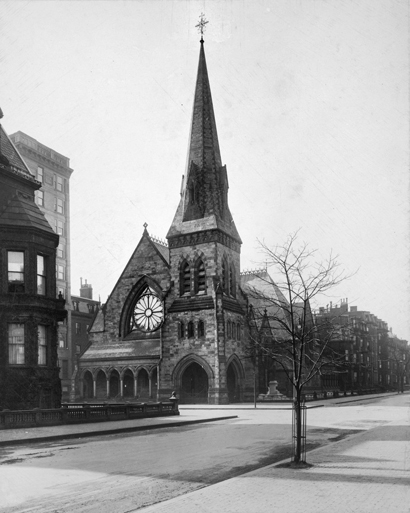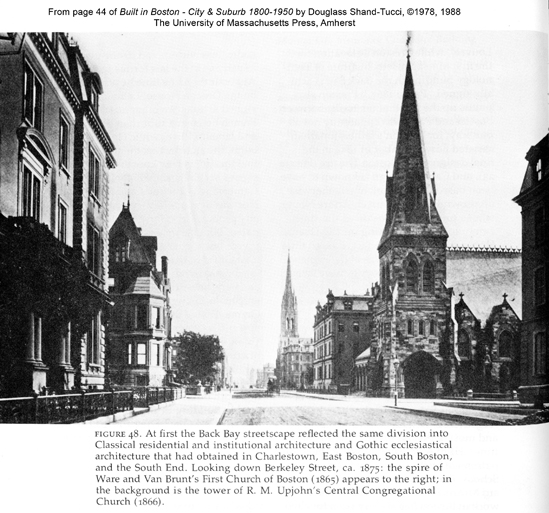Fifth Building 'The Cathedral in the Back Bay'
First Church
Boston
1868
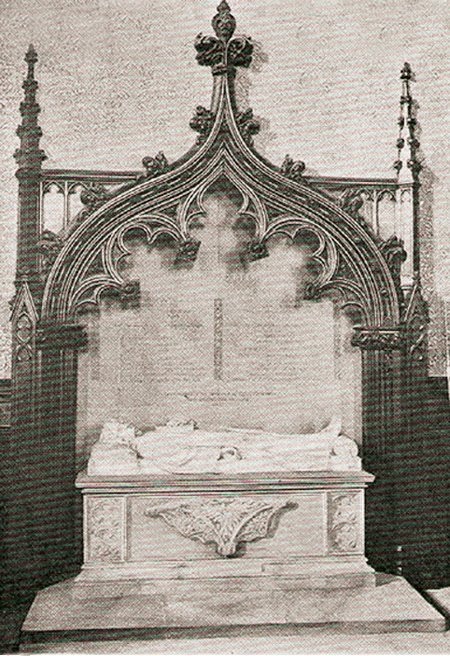
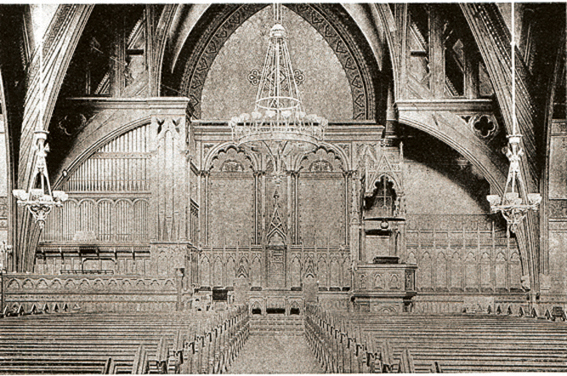
Ware and Van Brunt were the architects of the Fifth Building of what could be called Boston's heritage church. Van Brunt was a member of the church.
They were also the architects of Harvard's Memorial Hall, and one can see a similarity in the roof tiling, and the interior. The church was inspired by Westminster Hall in London, England. Dark wood paneling and marble memorial plaques lined the wall. Stained glass windows were colored with glass made from an ancient European formula.
There was a life-size marble effigy of John Cotton by Bela Pratt, and a statue of John Winthop outside on the lawn.
In 1968, one hundred years after its inauguration, it burned to the ground.
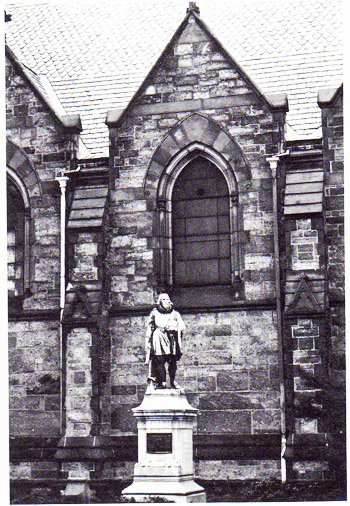
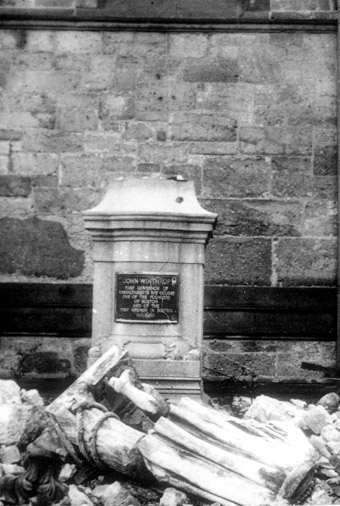
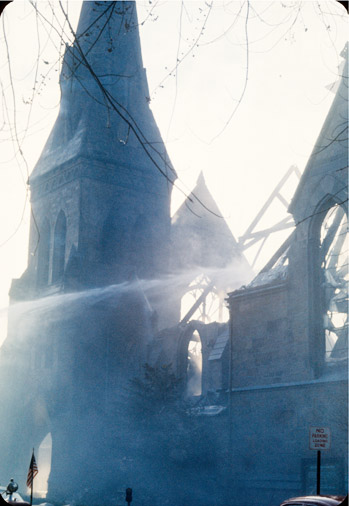
The following is the sermon that Reverend Rhys Williams preached on the Sunday after the fire:
MARCH 31, 1968
As Spring Came
(The service was held at the first Lutheran Church in Boston
two days after the burning of the fifth building of the First
Church in Boston which had been completed in 1868.)
IT IS A STRANGE FEELING to have to give a sermon
of this type. I see in our congregation this afternoon Dr. Max
Kapp, who was dean of the Divinity School of St. Lawrence
during my training. He prepared me for many services, but not
for this one, except by example. He, too, experienced the burn-
ing down of a building; in his case, his theological school.
We as the First Church in Boston, gathered in 1630, enter
the spring of 1968 with our sanctuary gone. So many centuries
ago as spring came, a man rode on a donkey into Jerusalem. He
felt that his message of a new order and a new way was about to
be accepted by the masses. Jerusalem's people would be one—
even the Samaritans. Her slums would disappear and beauty
would reign where ugliness had held its grip. Violence as a means
of solving differences would be retired, and a new communication
of understanding would permit horizons of love to appear
between peoples and nations and generations. And yet, almost
overnight, the outstretched hands were withdrawn. Was Jesus to
be a failure? Was all that he stood for to die, and nevermore to
be? We know he was crucified. But the ideals to which his life
had been committed would ever serve other people as a way
towards which the individual and his society must travel. What
was essential for the spirit gained a new emphasis, a new begin-
ning, and a new resurrection following his death.
As spring approached in 1968, the First Church in Boston
seemed to be taking on new depths, new dimensions, and new
fulfillments towards the ideals of Jesus. Never since the begin-
ning of my ministry in our Church in 1960 have we had more
varied and active groups than at present. Never has our outreach
beyond ourselves been broader than today- We have felt that
something of us had become fulfilled when we opened Hale
Chapel to groups outside our own congregational needs. We felt
that we were encouraging responsible people to remain in the
city when we were the catalyst for the development of the John
Wmthrop Nursery School, which now has a waiting list and
which needed space for a kindergarten. And this spring the
Social Concerns Committee has created channels for our people
to act constructively in other areas of our city where needs are
often greater than our own and where the resources to meet them
are less known. For a long time there have been many things we
have been doing for others through the John Clarke Fund and
the South Friendly Society and many other agencies. Here, how-
ever, in a new way, with a new approach, and a new avenue for
our people we were helping others to learn better how they may
help themselves,
We have enjoyed increasing interest in our Sunday morn-
ing programs, from the worship service to the Laymen's
League Breakfasts, the Beacon Book table, the display of dif-
ferent concerns and opportunities, the sermon discussions,
and those uplifting paintings of Alice Holcomb’s. We seem to
be increasingly giving witness To the spirit of those men and
women honored on our historic church walls: Simon
Bradstreet—"responsibility and trust," Anne Hutchinson—"a
persuasive advocate of the right of independent judgment,"
JohnWinthrop—"who spent his strength and his substance in
the cause of New England," Henry Vane—"a foe to every
tyranny, and a life-long champion of the Rights of Man." I
felt that we were on the verge of new breakthroughs, new
commitments, new enthusiasms and growth. Perhaps in a
sense we were beginnmg to feel the exhilaration of Jesus at the
time of his triumphal entry. And then suddenly in one night,
our home, our historic center of worship built by loving hands
and maintained to glorify God and the ideals of men and
women, was gone.
Friday morning, at 2:15 a.m., the phone rang. Was it a
tragedy that had befallen a family or an individual? Was it some-
one with a serious problem? Such thoughts race through your
mind at such an hour. The call was from a neighbor. The worst
fire she had ever seen was raging near Berkeley and Marlborough
Streets. "Was it our church?" She didn't know, I dressed quickly.
The phone rang again, and this tune it was my mother, who had
seen a fire in the same area. Even then, I couldn't believe that our
church was aglow with flames.
Entering a taxi, I asked to go ro Berkeley and Marlborough
Streets, 'I’ve just been down in that area," he replied, "but I won't
go back in that area. It's terrifying, The church is going up in
flames. The whole city may burn." ''What church?" was my quick
question. "The First Church," was the answer, "the Unitarian
Church.” "I'm one of its ministers," I said. As he dropped me at
the corner of Arlington and Marlborough Streets, the man was
almost in tears. He refused the fare and said In a very low voice,
“I’m sorry”
As I walked up Marlborough Street, the flames were shooting
above our tower, The cinders were flying in a wide arc. It was obvi-
ous that the building was going. There was no hope of saving it. It
is then that your thoughts go to the responsibilities ahead. As you
see the church burning and buildings nearby catching fire, your
concern is for the loss of life that could be occurring. Should you
notify the Chairmen of the Standing Commirree and the Trustees?
But they are both doctors; they need their sleep, for people's lives
rest in their hands. And there is nothing now to do but watch and
to mourn—to think of the irreplaceable memorials that are gone.
And then in the daze of the flying embers, you see Park
House. Here are the records of the Church that existed for cen-
turies. Can they be saved? You finally find someone in authority
to give you permission to enter.
You see that the office is locked and filled with smoke, and
then you notice the portrait of Dr. Park and you take it off the
wall to remove it from the building. You are thankful he did not
live to see this moment. The beauty of his spirit lovingly nur-
tured our church for almost sixty years. But then you are assured
that they are going to save this building, because a member of
the Social Concerns Committee had returned, after leaving Park
House at 11 o'clock that night, to confirm that the fire door
berween Park House and Hale Chapel had been closed. And
it was because of this thoughtful act that our records going
back to 1630 and the base of our programs and operations
were saved.
Watchfully through The night, you see the fire die. You still
look at Park House, hoping the flames will not ignite the roof
and wincing slightly as you see water hit the windows and break
one or two. It is, in a sense, like an hour at the cross. Everything
that so many for so long had striven to accomplish and to
achieve, and which was symbolized in this sanctuary, seems to be
destroyed. and the words of Job stab your thoughts: "My days
are past, my purposes are broken off—even the thoughts of my
heart. And where is my hope?"
Then, through the numbness of the dawn hours, you think
of the members of this Church who have come to you in tears,
but with affirmation that, "We will go on! We will rise to greater
triumphs." And the coffee you drink, that is brought by a mem-
ber of the Church, has another type of warmth. People who have
always passed you silently on the Back Bay streets begin to come
up to you one by one or in couples-.They tell you that though
they seldom go to church, though they are not Unitarians or
Universalists, they always have felt that the First Church is their
church. To them it was more than just another church in the Back
Bay. It was like the parish church that crossed the lines of histo-
ry and even nations to represent the pioneering spirit. They want
to do anything they can to help—to see this congregation rise
again like a Phoenix from this rubble. They offer to type, to push
brooms and to do just about anything we might ask them.
After you leave the scene, you find your home clustered with
friends and parishioners, with offers of help coming from every
quarter. The first donation for a new start comes from a Globe
reporter. You begin to realize that the days and idealisms of the
First Church are not just of the past. Perhaps with this new sense
of purpose rising amidst us, this tragedy, sorrowful as it is, will
not defeat us.
As notes and telegrams have come in, expressing such senti-
ments as Lawrence Perrera's, "I am hopeful that you and your
vestry will determine to re-build on this important site, and I
want to offer on behalf of the Back Bay Neighborhood
Association any encouragement and assistance I can in enabling
you to do this." Or the words in a telegram from the Executive
Director and Chairman of the Dorchester Area Planning Action
Council, where just recently we have sought to be of assistance,
"Due to your great loss our hearts go out to you and your con-
gregation. All is not lost because with God's help, we, the staff
and Board of Directors of the Dorchester APAC will extend our
hands in whatever way we can to help you to rebuild your
church," As all of these and so many more from Florida, South
Carolina, Illinois, California, offer their hearts and their sup-
port, it makes me quite realize that we have become more alive
as a congregation now than perhaps we have been in recent years.
We will have to work hard; We will have to go the second
mile with each other. We will have to learn to communicate in
ways that we never thought possible. We will have to hold each
other together by our mutual and loyal participation. But this
challenge is an opportunity. For more than brick and mortar, we
are people. We are a living church. We are the ones that decide
whether a church is more than a past, more than rote present, but
a challenging and leading spiritual force in the mainstream of a
growing, creative part of humanity. This is the spirit that will
bind us together in these homeless days. The First Lutheran
Church, which has so kindly let us use its sanctuary this after-
noon, turns often, I am sure, to these words of Martin Luther,
"For the sermon of God comes in order to change and revive the
whole earth." This is a spirit that we as a living church must carry
forward— continuing our works, sharing in our worship, and
looking to new avenues of service. These will not be easy times,
First. We will have to call on our faith to a much fuller degree
than we probably have been doing,
Second. We will have to remember the wisdom in Hebrews,
"Wherefore we also are compassed about with such a cloud of
witnesses, let us set aside every weight and the sin which doth so
easily beset us and let us run with patience the race that is set
before us,"
Third. We will have to keep in mind real needs in our
community as we go about the details of our building re-
development. These lines from Rhoda Denison give us the warn-
ing signal that we can become so wrapped up now in ourselves
and our own needs that we will forger the needs of others whom
we must continually serve during this period: "It was a city of
lilacs, a city of fragrant sanctity, a city of churches and syna-
gogues. It thanked God for making it liberal, for making it tol-
erant of its brethren. The untouchables, the different. It opened
its purse, and money poured on the halt and the blind. There
seemed to be no limit to its generosity, its outreach, its concern
for the needy, for those in want, unless, of course, the want was
a decent place to live, a clean place of fields and skies, of fresh
air and freedom. Then the lilac city, the city of sanctity, closed
its purse, closed its doors, closed its heartt and hurried away. To
forget by loud talk, by forming committees, by endless and eter-
nal business, and once again, Love was nailed to the Cross." In
facing tomorrow with imagination and vision, let us not lose
sight of the spiritual outreach that we must not only continue
but also expand.
Fourth, We will have to keep in mind that the essentials of
religion are rooted more in people than in buildings. Therefore,
the building that is constructed should have aesthetic effects
that are proper and fitting for the religion and the idealism
that we espouse. Religion is inherent in people's hopes and
desires and ideals. Largely, it shapes the nature of our moral
community and spiritual life. Beauty in our symbolic church
has profound responsibilities in sustaining our spirits towards
higher goals.
Fifth. We musti remember that the essentials are still with us.
Your ministry is intact. There was no loss of life in the fire. You
as a congregation have visibly rallied in your determination to
live on, to grow and to expand in every way. Next Sunday, Palm
Sunday, we will recognize new members. It is a time when peo-
ple who have often thought about membership with us can come
forth to a new experience where they will know that they are not
only needed but where they will enjoy an exhilarating and cre-
ative period ahead as members of our congregation- And on
Palm Sunday, the Covenant of our Church dating from 1630
will be read. This document has survived five buildings and the
Revolution. What is it but a suggestion of the permanence of
the deep, essential truths on which a living church rests?
Can we survive this crisis? The answer is assuredly, "Yes!"
When people are happy together, they build something eternal.
No fire destroys this. As Darnel Burnham has phrased it, "Make
no little plans, they have no magic to stir man's blood, and prob-
ably themselves will not be realized. Make big plans; aim high in
hope and work, remembering that a noble, logical diagram once
recorded, will never die, but, long after we are all gone, will be a
living thing asserting itself with ever growing insistence.'
May the stones that we build with our lives be sacred, because
we touched them with our creativity and vision. May they touch
people and transform lives. May they uplift and carry us and
others through the deep valley that we now experience to new
high peaks. We are not forsaken. We have been handed a mantle
of trust and responsibility in a major American city. How sym-
bolic of these times when people so often wish to tear down. But
let us, through our hard work, dedication, commitment and love,
build a new church that will inspire and develop people to
greater fulfillment. What we do will stand as a symbol of
patience, insight outreach and concern. We will speak with
significance and challenge to this day. We will become a symbol
of a people who had imagination and vision for those who come
after us.
According to the ancient mystical legend, the Phoenix, sacred
to the Egyptian Sun-god, Ra, every five hundred years built a
funeral pyre of wood, which it ignited, and with its fanning
wings, rose to new heights of strength and power.
Now, is this not the opportunity for us and for those who
will join wirh us in this exciting adventure ahead? Where the
stones have fallen, we will build with new brick. Where the beams
lie charred, we will re-create with new timbers. Where the word
is unspoken, we will build with new speech a church for us all, a
work for us all, a chance for us all to participate with the ideal
and with the divine. As spring came this year, the First Church in
Boston and its members and friends see amidst the darkness a
light leading to new vistas of beauty and service and love.
Let us pray. O God, as we go forth to do our part and to
expand our horizon, may our hearts in sympathy go out to those
persons who suffered with us in this fire. For those who lost
their homes and their treasures, give us the strength in the midst
of our sorrows to be a stay and a help to them. Amen.
